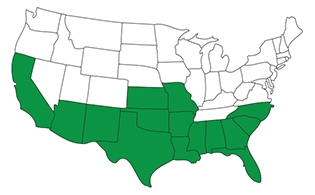
Bermudagrass Mite
Eriophyes cynodoniensis
The Bermudagrass Mite is a miniscule lawn pest that can be found anywhere that Bermudagrass is established. These tiny mites are typically found throughout much the southern United States, from Florida to California, and as far north as Missouri.
Identify

Leaf & Stem
The Bermudagrass Mite can be identified by its tiny size and elongated, worm-like, pear-shaped, light-yellow body. This lawn pest has only two pairs of short, forward-projecting legs and lives and feeds under the leaf sheaths of grass. It's typical to first notice damage from the Bermudagrass Mite in the spring when some home lawns appear weak and don't respond to irrigation and fertilization. The affected grass appears stunted and slightly yellow with significantly reduced spacing in between nodes. Grass leaves and buds become bushy, forming a rosette or turf with a “witch's broom” appearance. Heavy infestations of the Bermudagrass Mite produce an open, “tufted” appearance. The damage from this lawn pest is most severe during hot, dry weather.
Life Cycle
Little is known about the Bermudagrass Mite life cycle due to this lawn pest's small size. If conditions are right, an entire life cycle—from egg lay to full adulthood—can complete in 10 to 14 days. This rapid timeline helps explain how this lawn pest is able to quickly overrun and infest Bermudagrass lawns.

Control
There are two methods for controlling Bermudagrass Mites that TruGreen® recommends: 1. Use professionally applied pest control designed to prevent excess lawn pest populations, which can cause damage to your lawn 2. Kill insects, grubs and other lawn pests before they have a chance to damage your lawn Proper mowing and watering techniques can also help foster a healthy lawn that's more tolerant to lawn pest attacks—plus you'll get a lawn you'll want to live on in the process.







